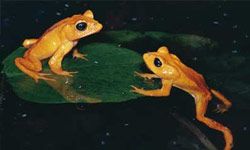Quck answer
Amphibians can be identified based on their unique physical features and behavior. Some key characteristics to look for include smooth, moist skin, four legs, and the ability to breathe through their skin. To identify a specific species, it is important to observe their behavior, habitat, and vocalizations. Field guides and online resources can also be helpful in identifying amphibians. It is important to handle amphibians with care and avoid touching them with bare hands, as some species can be toxic or carry diseases.
Wild Animals

Michael
Amphibians, such as toads, frogs, and newts, belong to a class of the animal kingdom. The word “amphibian” comes from a Greek word that means “a being with a double life.” These creatures have two stages of development, which are the larval stage and the adult stage. Tadpoles are the larval stage of frogs. Most amphibians can live both in and out of the water, but some live only in water and others only on land. Amphibians are fascinating animals with unique features and characteristics. Follow the tips below to learn how to recognize the amphibians in your area.
- Appearance: The appearance of different amphibians is the most distinguishing characteristic. Frogs have smooth skin and long, muscular legs. Some species may have markings on their skin, such as spots or stripes. Frogs also have marks behind their eyes that cover their eardrums. Toads, on the other hand, have rough skin and are covered in warts. They have shorter legs and fewer markings on their skin. Newts look more like lizards with long bodies and short legs. Their skin texture, color, and markings vary greatly among species.
- Movements: Different species of amphibians move differently, which provides clues to identify whether you are looking at a toad or a frog. Frogs hop from place to place, while toads crawl. If you disrupt an amphibian in its natural surroundings and it hops away, then it was a frog. Toads tend to stay still rather than fleeing when they are disturbed.
- Spawn: The appearance of amphibian spawn varies greatly among the species. Frog spawn grows in clumps near a source of water. Toad spawn is in strings with rows of eggs in lines. Newts wrap each of their eggs in an individual leaf.
FAQ
1. What are amphibians?
Amphibians are a class of cold-blooded vertebrates that live in water and on land. They have smooth, moist skin and lay their eggs in water.
2. What are some common types of amphibians?
Common types of amphibians include frogs, toads, salamanders, and newts.
3. How can you tell the difference between a frog and a toad?
Frogs have smooth, moist skin and are often found near water. Toads have dry, bumpy skin and are usually found on land.
4. What is the best time of day to look for amphibians?
The best time of day to look for amphibians is early in the morning or late in the evening when they are most active.
5. What is the difference between an amphibian and a reptile?
Amphibians have smooth, moist skin and lay their eggs in water. Reptiles have dry, scaly skin and lay their eggs on land.
6. How do you identify a salamander?
Salamanders have long, slender bodies and smooth, moist skin. They are usually found near water and have four legs.
7. How do you identify a newt?
Newts are small, slender amphibians with brightly colored skin. They have four legs and a long tail.
8. What is the difference between a newt and a salamander?
Newts are a type of salamander that spend part of their life in water and part on land. They have brightly colored skin and a long tail.
9. How can you tell if an amphibian is poisonous?
Many amphibians are poisonous, and they often have brightly colored skin as a warning. If an amphibian has bright colors, it is best to avoid touching it.
10. What should you do if you find an injured amphibian?
If you find an injured amphibian, it is best to leave it alone and contact a wildlife rehabilitation center. They will be able to provide the proper care for the animal.
11. How can you help protect amphibians?
You can help protect amphibians by not using pesticides in your yard, supporting wetland conservation efforts, and not disturbing their habitats.





Leave a Reply